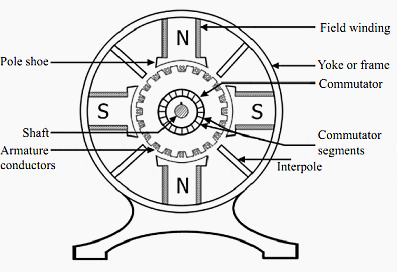General about DC motors
Separate field excitation DC motors are still sometimes used for driving machines at variable speed. These motors are very easy to miniaturize, and essential for very low powers and low voltages.They are also particularly suitable, up to high power levels (several megawatts), for speed variation with simple, uncomplicated electronic technologies for high performance levels (variation range commonly used from 1 to 100).
Their characteristics also enable
accurate torque regulation, when operating as a motor or as a generator.
Their nominal rotation speed, which is independent of the line supply
frequency, is easy to adapt by design to suit all applications.
Construction of DC motor //

DC motor construction parts
A DC motor is composed of the following main parts:
Field coil or stator
This is a non-moving part of the magnetic circuit on which a winding is wound in order to produce a magnetic field. The electro-magnet that is created has a cylindrical cavity between its poles.Armature or rotor
This is a cylinder of magnetic laminations that are insulated from one another and perpendicular to the axis of the cylinder. The armature is a moving part that rotates round its axis, and is separated from the field coil by an air gap. Conductors are evenly distributed around its outer surface.Commutator and brushes
The commutator is integral with the armature. The brushes are fixed. They rub against the commutator and thus supply power to the armature conductors.Click here for the full article
No comments:
Post a Comment